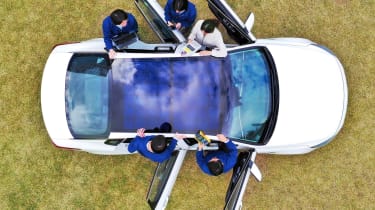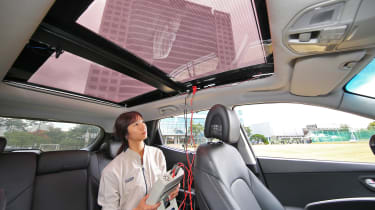Message #30208 from Auger50 at 4/26/2020 8:38:10 PM wrote
What does the investment mean?
I think it would mean they would love to get rid of that heavy, bulky power shade in picture #2,
~~~~~~~~~~~~~~~~~~~~~~~~~~~~~~~~~~~~~~~~~~~~~~~~~~~~~~~~~~~~~~~~~~~~~~~~~
Hyundai and Kia to apply solar charging tech to new carsThe use of solar panels will improve efficiency on Kia and Hyundai's combustion, hybrid and EV ranges from 2020

Hyundai and Kia are set to introduce solar charging to many of its new cars. The technology, which will first feature as early as 2020, will be applied to electric, hybrid and combustion-engined vehicles to improve efficiency.
The solar panels will be applied to the roofs of a variety of new models, supplementing the existing power sources. The new tech will be introduced in three different set-ups.
The first introduction of the technology will be applied to hybrid models. Weather permitting, the silicon panels are capable of adding between 30 to 60 per cent of charge to the car’s battery over the course of a day.
 The next generation of panels will be introduced to traditional combustion models, and these will be designed to help the bulk of Kia and Hyundai’s ranges comply with ever-tightening emissions regulations. The most interesting feature of the second-gen panels is that they’re semi-transparent, allowing them to be applied on top of sunroof-equipped cars. This will be, according to Kia and Hyundai, a world-first application for the technology. The next generation of panels will be introduced to traditional combustion models, and these will be designed to help the bulk of Kia and Hyundai’s ranges comply with ever-tightening emissions regulations. The most interesting feature of the second-gen panels is that they’re semi-transparent, allowing them to be applied on top of sunroof-equipped cars. This will be, according to Kia and Hyundai, a world-first application for the technology.
The third generation of solar tech will be applied to the brands’ fully electric models. This system is still under development, but will be eventually be applied to both the bonnet and the roof of EVs to keep the battery topped up.
The electricity from the panels can be used in two ways: either to directly charge the battery, or sent directly to the car’s AC generator to reduce load.
Speaking of the new tech, Jeong-Gil Park, Executive Vice President of the Engineering and Design Division of Hyundai Motor Group, said: “In the future, we expect to see many different types of electricity-generating technologies integrated into our vehicles. The solar roof is the first of these technologies, and will mean that automobiles no longer passively consume energy, but will begin to produce it actively.” |






 The next generation of panels will be introduced to traditional combustion models, and these will be designed to help the bulk of Kia and Hyundai’s ranges comply with ever-tightening emissions regulations. The most interesting feature of the second-gen panels is that they’re semi-transparent, allowing them to be applied on top of sunroof-equipped cars. This will be, according to Kia and Hyundai, a world-first application for the technology.
The next generation of panels will be introduced to traditional combustion models, and these will be designed to help the bulk of Kia and Hyundai’s ranges comply with ever-tightening emissions regulations. The most interesting feature of the second-gen panels is that they’re semi-transparent, allowing them to be applied on top of sunroof-equipped cars. This will be, according to Kia and Hyundai, a world-first application for the technology.